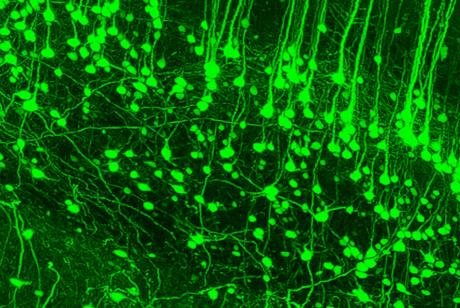A new imaging technique has enabled scientists to see neuronal structures of the cortex in unprecedented detail. Photo by LMU
MUNICH, Germany, Aug. 22 (UPI) -- Scientists at Ludwig Maximilian University have developed a technique for turning the body of a deceased rodent entirely transparent, revealing the central nervous system in unprecedented clarity.
Researchers are hopeful the new and improved view will help scientists understand how traumatic brain injuries, strokes and aging yield chronic disorders like dementia and epilepsy.
The clarifying technique is made possible by a cleansing solvent, which over a period of a few days rids the rodent's body of all its water and most of its fat. The "tissue clearing" technique also shrinks the size of the body, making the internal structures -- bones, muscles, nervous system and other organs -- easier to study under a microscope.
To highlight a specific structure for study -- like the nervous system -- researchers use a glowing green protein. Scientists then image the induced luminescence using a variety of laser scans, creating a 3D image of the transparent mouse and its glowing nervous system.
Researchers can differentiate between different cells and neural circuits by employing a variety of fluorescent markers or antibodies.
"Since it allows individual cells to be localized, the method could be used to detect and characterize metastatic tumors at an earlier stage than is now feasible, or to monitor how stem cells behave in the body following a bone-marrow transplant," Ali Ertürk, a lead scientist at the LMU Medical Center's Institute for Stroke and Dementia Research, explained in a news release.
Ertürk and his research partners began by perfecting their cleansing and imaging process with mice, but have since scaled up the technique with rats.
"It might be possible with larger animals, such as small monkeys, and possibly a whole human brain for the first time in the near future," Ertürk told New Scientist.
Researchers detailed the new technique and its biomedical potential in the journal Nature Methods.















